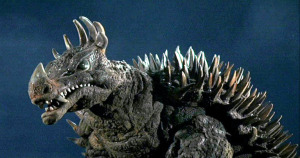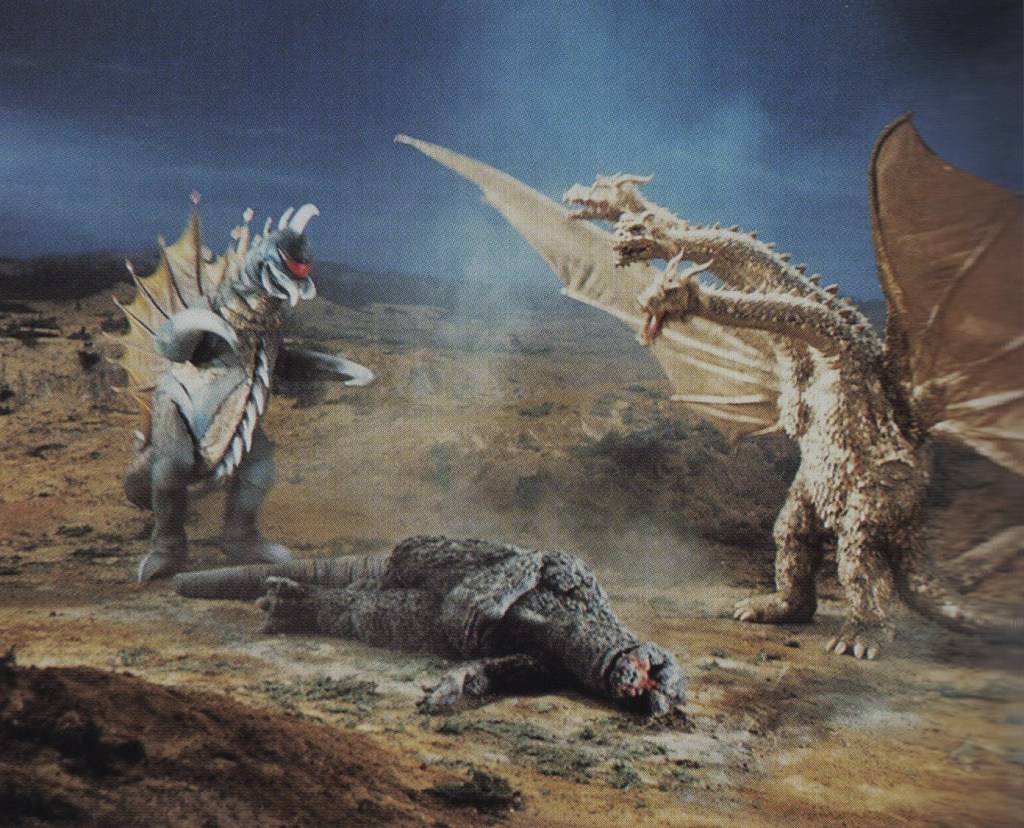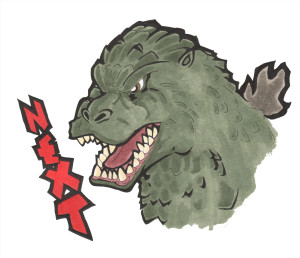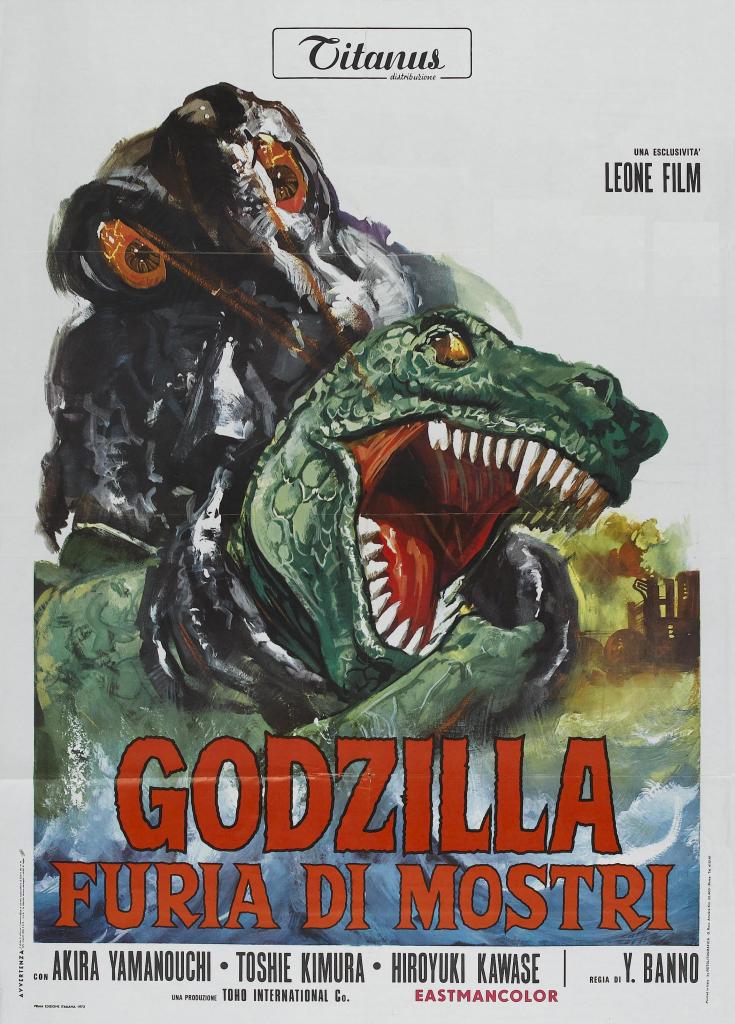Godzilla VS Gigan ~ 1972, Jun Fukuda – Japan
After the radical change of pace that was Godzilla VS Hedorah we are again back in step with more traditional Toho fare on Godzilla VS Gigan, yet another recycled alien invasion/Godzilla film, directed by Jun Fukuda. Godzilla VS Gigan reuses, for the two billionth time, several plot devices introduced to the franchise way back in 1964’s Ghidorah: The Three Headed Monster, but Fukuda manages to breathe a little bit of life into the picture with his zesty directing and keeps it feeling fresh enough… But just barely.
THE PLOT~ Gengo is a struggling, out of work cartoonist (Preaching to the choir, buddy) with a resourceful nature and a plucky thirst for adventure. While at a job interview (Wait, what?! You serious?!) Gengo becomes suspicious of his would be employers, World Children’s Land, who are currently building a theme park intended to promote world peace and also giant, horrible monsters who smash and kill people. Gengo, falls in with a few other characters interested in exposing whatever conspiracy World Children’s Land has brewing, and together they uncover the truth. You’re never gonna believe this, guys, but the people running World Children’s Land are actually a bunch of body snatching aliens. Thin ice, Toho, you’re really pushing it. Anyway, these aliens, who are actually giant cockroaches wearing human holograms, intend to destroy mankind, and also Godzilla, and their plans to accomplish this involve two space monsters, whom they control. Gengo and his pals plan to put a stop to this astro-roach bullshit, and that’s the movie.
Let’s do a Monster Roll Call.
- Godzilla–
 Once a towering, insurmountable force for death and destruction destined to blanket the Earth in grim darkness, fire and blood, Godzilla is now totally cool and nice, you guys. Not only is he no longer a bad guy, but in Godzilla VS Gigan, he’s a damn underdog. Most Godzilla films portray him as an unstoppable, scaly juggernaut, the unbeatable conclusion to any conflict, but in GVG it kinda seems like his monstrous snout has finally bit off more than it can chew. He really takes a lot of abuse this time around, including, at one point, a full on Ghidoriah lightning bolt attack to his dragon balls. Rough. (NOTE: Apparently, this shot is actually recycled footage from Ghidorah: The Three Headed Monster. So, apparently this has happened to Godzilla twice now!)
Once a towering, insurmountable force for death and destruction destined to blanket the Earth in grim darkness, fire and blood, Godzilla is now totally cool and nice, you guys. Not only is he no longer a bad guy, but in Godzilla VS Gigan, he’s a damn underdog. Most Godzilla films portray him as an unstoppable, scaly juggernaut, the unbeatable conclusion to any conflict, but in GVG it kinda seems like his monstrous snout has finally bit off more than it can chew. He really takes a lot of abuse this time around, including, at one point, a full on Ghidoriah lightning bolt attack to his dragon balls. Rough. (NOTE: Apparently, this shot is actually recycled footage from Ghidorah: The Three Headed Monster. So, apparently this has happened to Godzilla twice now!) - Anguirus–
 Anguirus has also come a long way from being Godzilla’s most hated rival to the sturdy, dependable, four legged BFF we see in GVG. Now he’s like, the “solid dude” of the kaiju kingdom, Anguirus is the monster who would come over to help you move. I mean, he’s a quadruped, with no apparent dragon breath or laser eyes, so his offensive capabilities are pretty much limited to biting and just being spiky, but he’s still out there in the fray, taking his lumps and doing what he can to back up his bros. If Godzilla seems like the underdog in this battle, Anguirus is straight outclassed, and you might find yourself worried about the little guy. I know I was!
Anguirus has also come a long way from being Godzilla’s most hated rival to the sturdy, dependable, four legged BFF we see in GVG. Now he’s like, the “solid dude” of the kaiju kingdom, Anguirus is the monster who would come over to help you move. I mean, he’s a quadruped, with no apparent dragon breath or laser eyes, so his offensive capabilities are pretty much limited to biting and just being spiky, but he’s still out there in the fray, taking his lumps and doing what he can to back up his bros. If Godzilla seems like the underdog in this battle, Anguirus is straight outclassed, and you might find yourself worried about the little guy. I know I was! - King Ghidorah–
 What is Ghidorah the king of, anyway? Pissing me off, that’s what. Anytime aliens pop in, they summon Ghidorah from the cold recesses of space to shriek, fly around, wiggle his three heads and barf lightning at everybody. GVG is no different, which proves just how successful his outer-space Craig’s List ads are.
What is Ghidorah the king of, anyway? Pissing me off, that’s what. Anytime aliens pop in, they summon Ghidorah from the cold recesses of space to shriek, fly around, wiggle his three heads and barf lightning at everybody. GVG is no different, which proves just how successful his outer-space Craig’s List ads are. - Gigan –
 This guy is the big addition to GVG. Gigan is basically like, the Boba Fett of the Kaiju world. He’s a cypher, he has no purpose and no drive of his own, he’s here to do his job; kill monsters and bust shit up. He’s like a giant monster hit man, hired on by aliens to dish out the death, because truly, that is what he was made to do. This damn thing has no hope of ever living a normal life, and that is by design. Every limb he has ends in a straight up blade, his face alone has four different slicers poking out, and his fucking belly has a fully functioning buzz saw embedded in it. The only means of manipulating an object that Gigan has is to slice the hell out of it, even just picking something up is out of the question unless it can also be impaled in the process. He is super cool, though.
This guy is the big addition to GVG. Gigan is basically like, the Boba Fett of the Kaiju world. He’s a cypher, he has no purpose and no drive of his own, he’s here to do his job; kill monsters and bust shit up. He’s like a giant monster hit man, hired on by aliens to dish out the death, because truly, that is what he was made to do. This damn thing has no hope of ever living a normal life, and that is by design. Every limb he has ends in a straight up blade, his face alone has four different slicers poking out, and his fucking belly has a fully functioning buzz saw embedded in it. The only means of manipulating an object that Gigan has is to slice the hell out of it, even just picking something up is out of the question unless it can also be impaled in the process. He is super cool, though.
The big monster brawl at the end of the picture actually stretches on for quite a bit of screen time, but it’s excellent. Actually, it might be the best fight in one of these movies yet, certainly it owes more to the big throw down between Godzilla and Hedorah than what was seen in Ishiro Honda’s more reserved, classic feeling Godzilla pictures. Fukuda’s dynamic use of camera works wonders here, the fight feels epic, dirty, painful, frantic, desperate, and mean. Ghidorah and Gigan have the run of the place for most of it, and they really kick the shit out of our boys. Godzilla spends some time down for the count, with Gigan and Ghidorah almost toying with him, beating him mercilessly as he is unable to even regain his composure. Anguirus tries like hell to save Godzilla and take these mercenary dragons down, but he’s utterly outmatched, and thus, is subjected to a series of violent beat downs the likes of which he has not known in centuries. There’s actually a bit of monster blood spurting and dripping in this one, and it really ups the ante and gives this conflict a greater sense of urgency. These guys are really getting hurt!

As usual, a crucial part of the human plan to turn the tide is to defeat the aliens and free any monsters that might be under extra terrestrial control. In order to achieve this, Gengo and his pals launch the most harebrained scheme I’ve ever seen; they literally load a bunch of boxes of dynamite into the elevator of the alien control tower, and then drape a black and white poster with cartoon drawings of themselves in front of the boxes, hoping that this super intelligent race of aliens 1) won’t notice them loading up their elevator with boxes of explosives and 2) won’t know the difference between living breathing humans and black and white cartoons, and will therefore open fire, detonating the explosives and destroying Martian H.Q. It totally works. If your alien race is dumb enough to fall for that, welcome to the Darwin Awards, you do not deserve to continue your intergalactic imperialism.
As said before, this is mostly another “been there, done that” Godzilla film, but Toho manages to squeak by thanks to Fukuda’s talents and in the end we have yet another enjoyable entry in the franchise. It’s more than a little maddening to know that they really see no issue with repeating essentially the same plot over and over and over again, but whatever. I still liked it. Everything else works and even the human characters are pretty likable, except for Gengo. This a-hole turns down jobs and then models a cartoon monster after his attractive and supportive girlfriend who just so happens to have a black belt in an unnamed field of the Martial Arts. Dude- screw you, man. On behalf of unemployed cartoonists everywhere, I hope you are eaten by Rodan.
B







 n, he’s playing with Godzilla toys in his backyard. Throughout the film he claims to have dreams and premonitions of Godzilla rising up out of the sea to rescue mankind from Hedorah, who has evolved into a biped with the ability to fly, and has decimated Tokyo, leaving many dead. The film is presented in a strange, almost dreamlike manner, inter-cutting jazzy 70’s split-screen techniques, frightening hallucination/dream sequences, and even occasional short animated sequences, which really lends credibility to the idea that this film could actually just be Ken’s fantasy. Perhaps we never really leave the backyard and Ken’s clunky, plastic monster dolls are playing out the events of Godzilla VS Hedorah for us. While the movie certainly presents itself as being cannon, there is enough here to justify the “child’s fantasy” idea, and the movie is open ended enough, if you want it to be. Several important monster related plot points are triggered by Ken’s “visions”, and these sometimes carry an odd imaginative feel, such as when Ken claims to spot Godzilla lurking unseen by anyone else amongst the city’s skyline while riding a roller coaster.
n, he’s playing with Godzilla toys in his backyard. Throughout the film he claims to have dreams and premonitions of Godzilla rising up out of the sea to rescue mankind from Hedorah, who has evolved into a biped with the ability to fly, and has decimated Tokyo, leaving many dead. The film is presented in a strange, almost dreamlike manner, inter-cutting jazzy 70’s split-screen techniques, frightening hallucination/dream sequences, and even occasional short animated sequences, which really lends credibility to the idea that this film could actually just be Ken’s fantasy. Perhaps we never really leave the backyard and Ken’s clunky, plastic monster dolls are playing out the events of Godzilla VS Hedorah for us. While the movie certainly presents itself as being cannon, there is enough here to justify the “child’s fantasy” idea, and the movie is open ended enough, if you want it to be. Several important monster related plot points are triggered by Ken’s “visions”, and these sometimes carry an odd imaginative feel, such as when Ken claims to spot Godzilla lurking unseen by anyone else amongst the city’s skyline while riding a roller coaster.

